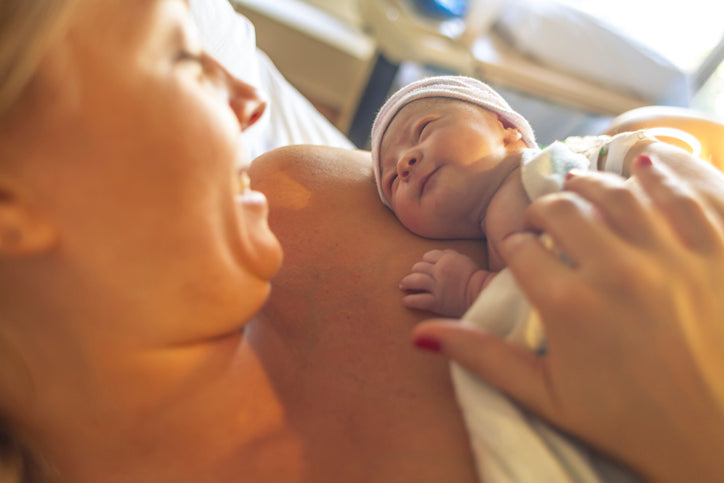The Golden Hour After Birth

In the rush to clean, weigh, measure, and generally check the health of a newborn, the baby may be missing out on some important bonding and other benefits with his mother. As long as there is no emergency, such procedures could be delayed for an hour or more so that the newborn can benefit from being skin to skin with the mother.
The Golden Hour is defined as the baby being skin-to-skin on the mother for an uninterrupted hour immediately following birth. In reality, it is so much more than this. Experiencing labor and birth is exhausting on both the mother and baby. It is the hardest work that the body (and the baby) has ever performed. Studies show that sharing the Golden Hour reduces the stress levels of both mother and baby.

Benefits of the Golden Hour
- Undisturbed Time: This time is quiet, peaceful and full of little to no interruptions. There is no one poking and prodding mom or baby, and the environment is calm and soothing.
- Both Mother and Baby’s Heart Rates are More Stable
- Baby Cries Less
- First Nursing Session is Better Digested
- Baby’s Body Temperature Remains Stable: A mother’s chest is warmer than any other parts of the body and can keep the baby from cooling down. That’s right, the mother’s body continues to regulate the baby’s body temperature even after birth.
- Risk of Infection for Baby Significantly Decreases: The mother’s good bacteria is picked up via skin-to-skin contact and protects baby.
- Physiological Signs of Stress Decrease for Baby: Instead of becoming lethargic or disassociated and crying in despair, the Golden Hour provides instinctual close contact to keep baby calm and allow the natural progress of newborn development to occur.
- Breastfeeding: The Golden Hour allows the natural act of breastfeeding to occur without pressure and on the baby’s timeframe.
- Bonding: Not only are mother and baby bonding, but father, mother, and baby are all getting to know one another.
- Reduced Risk of Hypoglycemia (Low blood sugar levels): Newborns can produce glucose from their body’s stored energy until they have figured out breastfeeding, but being skin to skin enhances their body’s ability to do so.
- Increase in Mother’s Confidence: Oxytocin receptors increase during pregnancy, and when a baby is born, the mother is more responsive to this hormone. Oxytocin promotes maternal instincts, and is produced in even larger quantities when breastfeeding and being skin-to-skin.
- Successful Breastfeeding Relationship: Mothers who enjoy this time period are more likely to have a successful breastfeeding journey. Even more so if the baby is left to self-attach to the breast without help or force.
- Protection Against the Effects of Separation: Babies are born with a mammal’s primal instinct to stay in a safe environment (With their mother). They preserve energy and heat this way, are comforted and feel safe.
Things to Note:
- When babies are born, they should be immediately placed tummy down on their mother’s stomach in a quiet environment with a blanket placed over both to keep them warm. This is to slow down the production of adrenaline hormone in the mother so as to not interfere with oxytocin and prolactin hormones being produced – essential for bonding and breastfeeding!
- The mother is still in labor at this time – for the delivery of the placenta. Typically, the placenta comes naturally within 10-45 minutes after baby is born, so a member of the birth team should be in the room, but staying hands off until it is time for the placenta to come.
- Unmedicated babies (meaning, no drugs at all during labor) who are placed skin to skin with their mothers (and left undisturbed) will instinctively crawl to the breast and attach themselves to breastfeed. This is now known as the ‘breast crawl.’
- The Golden Hour allows for complete cord pulsing before clamping and cutting. Leaving the umbilical cord intact, while it is still pulsating, after birth holds so many benefits for baby.
The Nine Stages of The Golden Hour
Skin-to-skin contact between mother and baby during the first hour or two after birth provides the natural location, and the cues, for baby to move through the nine instinctive stages. (If the mother isn’t able to hold baby skin-to-skin during this time then the father can take on this role.) If there are medical reasons why baby can’t be held skin-to-skin right after birth, then start as soon as possible.
During the Golden Hour, the sweet new baby is acclimating to life outside of the womb, and discovering his parents from the outside. He is learning to breathe, letting his eyes and ears adjust, regulating his temperature, and discovering how to breastfeed. There are nine stages that occur during this time, but you don’t need to keep track.
It’s just interesting to learn what your baby is experiencing! These stages are instinctual and will happen when a baby is able to lay skin-to-skin with his mother immediately after the birth, for at least an hour without interruption.
Stage 1: The Birth Cry
Baby’s lungs fill with oxygen for the first time, and he lets out a cry. Everything is bright, loud, and new. Being placed directly onto the mother’s chest (with blankets overtop of them), his cries will subside.
Stage 2: Relaxation
After crying, the baby enters the stage of relaxation. His mouth remains still, eyes may close, and hands will be soft and open. He will breathe gently and rest after the effort he put forth during the birth.
Stage 3: Awakening
Typically, around 5 minutes after birth, Baby will move his head and shoulders, opening his eyes and mouth. He may make small noises and open his hands a bit.
Stage 4: Activity
Movements increase and become more noticeable. “Rooting” for breastmilk begins. He may look towards mom or the breast and may use his hand-to-mouth signal to show hunger. He is preparing to latch. His instincts kick in.
Stage 5: Rest
Quiet stillness will occur throughout the Golden Hour, as baby is working hard and often needs to rest. He will move at his own pace.
Stage 6: Breast Crawl
Baby is born with a “stepping reflex” that allows him to scoot up Mom’s chest toward the breast. He will try to align himself with the nipple, and allowing him to do this on his own actually improves the chances of a successful latch.
Stage 7: Familiarization
Baby will learn the breast, becoming familiar with it. He may touch, rub, lick, and “talk” to the breast to get his mother’s attention. This raises the oxytocin levels in both mother and baby, creating a strong attachment, and signaling milk to start being produced.
Stage 8: Suckling
Between 45-60 minutes after birth, Baby will latch himself to the breast and begin to nurse.
Stage 9: Sleep
Both baby and mother tend to drift to sleep as baby nurses. Sleep may last a few hours and is much needed. Birth is tiring and the body needs rest to recover.








